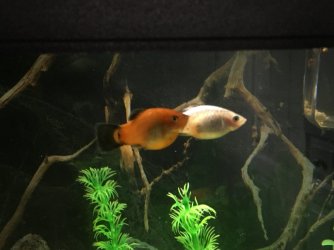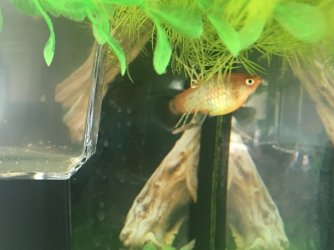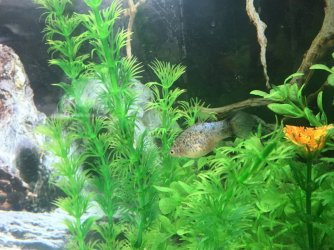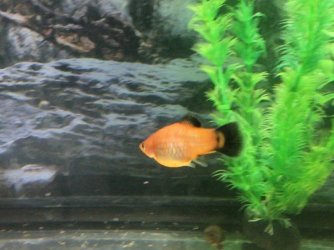Platy fish are also known as “livebearers” as they give birth to live fry (baby fish). If suitable habitat and environment are made available to the platys, then they are likely to start breeding soon. Also, if they are well fed and well-cared-for, they will not need much help and assistance with the breeding process.
Once a platy is pregnant, it will display a number of changes in its appearance as well as minor behavioral changes. In some cases, the expecting female might chase the male aggressively. It might also move to a secluded area of the tank, most probably to the bottom of the tank or in the shelter of some plant, right before it is about to give birth.
The most obvious physical changes occur at the gravid spot of the brooding females. This dark colored spot is situated between the anal opening and pectoral fins. It is caused by the stretching of the peritoneal wall. The physical changes that occur here are listed below:
- It will become much darker with the developing embryo. However, if the fish does not have light-colored scales, the color change might not be very evident. If your platy is about to have white-colored fry, then tiny black dots will be much more detectable than the color change. These black dots are basically the eyes of the young fry. Note that these will only be visible when the pregnant platy is close to giving birth.
- The abdomen region and size of the gravid spot will also greatly enlarge due to development of ovary and formation of eggs. Eventually, it will become bulky and might even move slowly due to the increasing weight of the developing embryo.
Gestation period and Pregnancy care
The gestation period of a pregnant platy lasts for about 24-30 days. During the gestation period, the maintenance of the aquarium is very important. The optimum temperature, for the reproduction process to occur rapidly is between 77 F and 80 F.
Lowering the temperature will result in the lengthening of the gestation period. Therefore, it is highly important to keep platy fish in bright light. Cool and dull light conditions might even stop the reproduction process.
Apart from that, the separation of male platies from your female platies is also necessary as they cause a lot of stress on the females. You might observe the males chasing around the pregnant females especially when they are about to give birth. It is because they are ready to feed on the newly born fry. This stress can result in the abortion of fry. The female will either deliver eggs or underdeveloped fry.
Birthing Process
Usually, the birthing process occurs at night, in the dark. When the female platy will be close to giving birth, it’s cloaca will become pea-shaped or dilated. Do not mistake this for constipation. It’s actually just preparation of birth.
After complete formation, the young platy will lie in a semi-circular position in the mother’s abdomen. The mother platy will give birth to the fry one by one, usually tail first. This process might take a few hours and the fry may be delivered by the mother over a period of 4-6 weeks in different batches.
The newly born fry will either sink to the bottom or hide into a nearby plant. They will lay still for a few moments but will regain strength to move about really soon. The young platy will feed on whatever the adult platys are feeding on. The micro-organisms in the breeding plants are also very nutritious for the young platy.
Breeding box
A breeding box is used to separate fish from the main community tank. Usually, pregnant platies are placed in a breeding box to save the baby fry from adult platy fish. However, separating the pregnant females causes stress for them. Especially if they are close to giving birth.
Therefore, it is not advisable to separate the female platy during its last few days of pregnancy. Rather, the male platys should be isolated before the female gives birth. The adult male and female platies can later be regrouped while the young fry should be kept isolated until they mature.
It is much better to place some live, bushy, floating plants such as hornwort in the tank than to place the pregnant platy separately in a breeding box. Floating plastic plants may be used as well. The stress a breeding box causes to pregnant platies can not only risk the life of fry but may lead to female platy’s death.
Care of baby fry
The live-bearer fish tend to eat their young as soon as they are born. For that reason, the very first measure to take is to arrange a separate tank or isolated place for the baby platys. You can do that in two ways; either move the mother to a separate tank before it gives birth, or you can separate the fry after.
A fishing net can be used to scoop and move the fry. If you are unable to arrange a different tank for your baby platys, then you can also place shelters and floating plants in the tank. They serve as hiding places for the fry and keep them from being eaten by adult platys.
The diet of baby platys is very similar to adult platys, except that they should be given small amounts several times a day. They should also be checked upon more regularly just to keep an eye on their well-being at such a vulnerable time of their lives.
(I made the last part of that big, just so you can remember it. I used to breed platys, so I
think my information is correct, but I’m not sure.
@Colin_T will you please see if I’m correct?)

Sorry for the long read, but I hope this helps!






